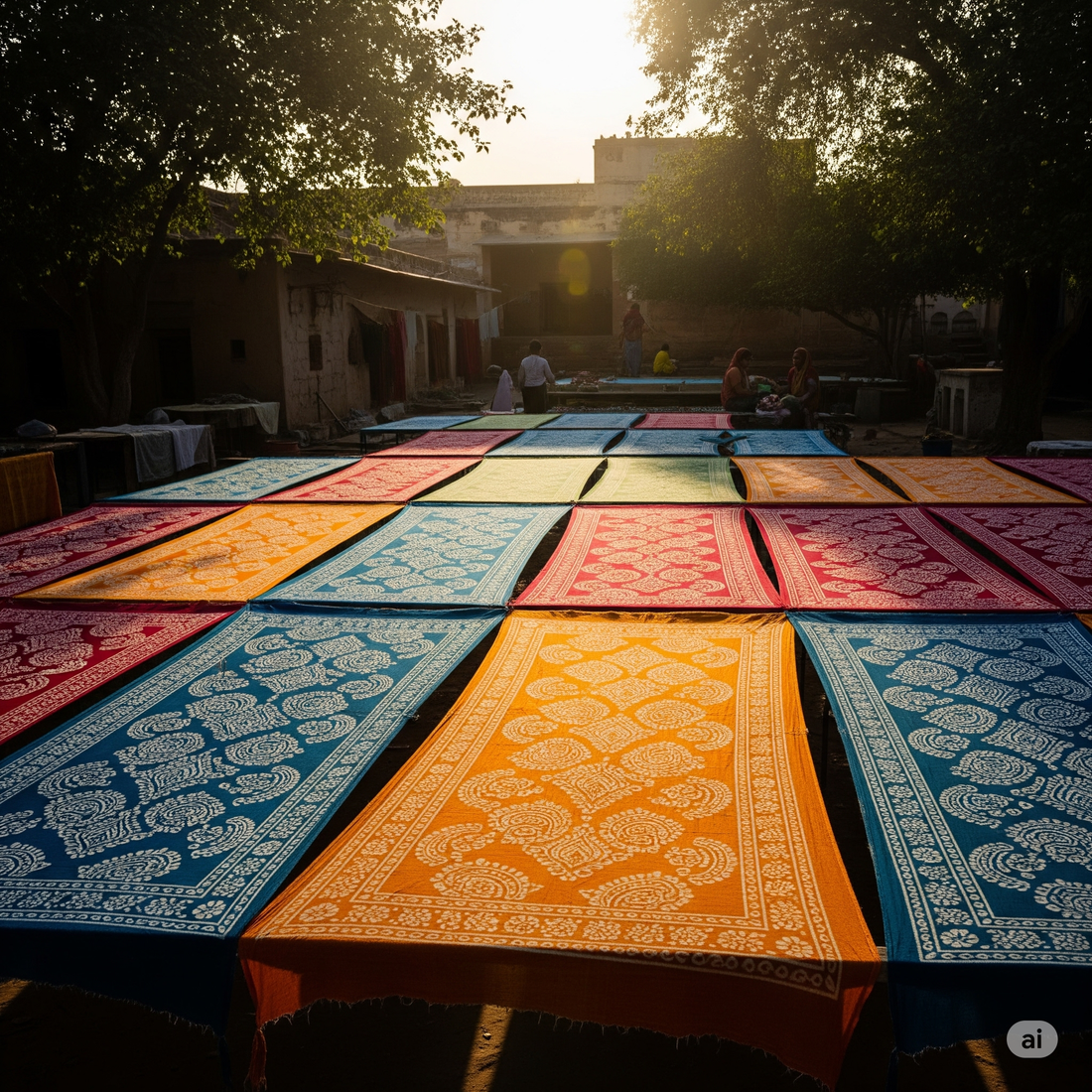
How Clothes are made using Datta Butti ? Full process explained
Share
The Ancient Art of Bagru: A Journey from Earth to Fabric
Nestled in the heart of Rajasthan, the quaint town of Bagru holds secrets of a timeless craft: block printing. More than just a technique, it's a legacy where the very earth lends its vibrant hues to cotton, creating intricate patterns that whisper tales of heritage and meticulous craftsmanship. Central to this art is the "Datta Butti" technique, where "Datta" refers to the specific wooden blocks used for filling in colors within a design, bringing motifs ('buttis') to life.
Let's embark on a captivating journey through the fascinating steps that transform plain fabric into a masterpiece of Bagru block print:
Step 1: Preparing the Canvas – Hari Sarana (Scouring)
The journey begins with raw cotton fabric, fresh from the mills, carrying natural impurities, starches, and oils. To ensure that the dyes penetrate evenly and deeply, the fabric undergoes a rigorous cleaning process known as 'Hari Sarana' or scouring. Traditionally, this involved soaking the cloth for days in a concoction of cow dung, soda ash, and sesame oil, followed by thorough washing. While modern methods might employ simpler detergents, the fundamental goal remains constant: to achieve a pristine, receptive canvas ready to absorb color.
Step 2: The Priming Touch – Harda Treatment
Once meticulously cleaned, the fabric is introduced to 'harda' (Terminalia chebula) powder, a potent natural mordant derived from a tannin-rich fruit. The cloth is immersed and dyed in cool water mixed with this powder, which subtly imparts a yellowish tint that gradually fades as the process unfolds. This crucial step acts as a vital primer, significantly enhancing the fabric's ability to absorb and retain the natural dyes. It's particularly essential for the deep, rich blacks that are a hallmark of Bagru prints, as the tannic acid in harda reacts with iron-based dyes in later stages, developing robust and fast colors.
Step 3: Sun-Kissed Canvas – Drying
After the harda treatment, the fabric is gently squeezed to remove any excess water. It is then meticulously laid flat under the expansive, warm Rajasthani sun. The abundant sunlight and clean water are not merely environmental factors; they are integral and indispensable components of almost every stage of the Bagru printing process, playing a critical role in the development, setting, and overall vibrancy of the natural colors.
Step 4: The Artisan's Tool – Block Carving
Before the first print touches the fabric, the very tools of the trade are themselves exquisite works of art. Wooden blocks, meticulously crafted from seasoned teak or sheesham wood, are central to the process. Each intricate design element and every distinct color within a pattern necessitates its own dedicated block.
-
Rekh: This is the outline block, which defines the main contours and structure of the design.
-
Gadh: The background block, utilized to fill in the base color of the fabric, forming the ground for the patterns.
-
Datta: These are the filler blocks, specifically designed to add colors and the finer, intricate details within the outlines, often used for smaller motifs or 'buttis'. The "Datta Butti" technique derives its name from the skillful application of these filler blocks to create beautiful, detailed designs. Following their carving, these precious blocks are often soaked in oil for several weeks. This traditional practice softens the wood grains, prevents cracking, and ensures the longevity of the blocks, guaranteeing clean and precise impressions for countless prints to come.
Step 5: Nature's Palette – Color Making
The very soul of Bagru printing resides in its vibrant, earth-derived dyes, meticulously prepared from natural sources. Generations of inherited knowledge guide the complex process of concocting these unique colors:
-
Black: A deep, resonant black is often achieved from a fermented concoction involving rusted iron (such as old horseshoes), jaggery, and molasses.
-
Red: A rich, earthy red is carefully crafted from madder root (sourced from the Aahl tree), blended with alum, and stabilized with natural gum paste.
-
Blue (Indigo): The legendary indigo dye, a symbol of natural beauty, is patiently extracted from the leaves of the indigo plant, fermented in special subterranean wells known as 'Naand', sometimes with additional ingredients like casatoria seeds to enhance its potency.
-
Yellow: Sun-kissed hues of yellow are obtained from dried pomegranate rinds, the vibrant spice turmeric, or the flowers of Dhabaria trees.
-
Brown/Grey/Khaki: These versatile, earthy tones are typically derived from 'kashish' (iron salts), offering a range of subtle nuances. Each color is a testament to natural alchemy, prepared through a meticulous process that often requires days of grinding, fermenting, and precise mixing to achieve the perfect consistency and hue.
Step 6: The Imprint – Printing
With the fabric perfectly prepared and the rich, natural dyes ready, the true magic of Bagru printing unfolds. The treated fabric is carefully stretched taut and securely pinned onto large printing tables, which are cushioned with multiple layers of canvas and jute to ensure an even and consistent pressure during printing. The printing sequence is a precise dance: typically, the 'Gadh' block is first used to apply the background color, creating the base. This is followed by the 'Rekh' block, which outlines the intricate designs. Then, the 'Datta' blocks come into play, meticulously filling in the colors and adding the fine, intricate details of the motifs. The skilled artisans, known as 'Chippas', work with a rhythmic precision, a craft honed over generations, carefully aligning each wooden block to create a seamless and continuous pattern that spreads across the fabric.
Step 7: The Final Fix – Washing and Finishing
The printed fabric is not yet complete. It undergoes a final, crucial washing process, which is as much an art as the printing itself. For certain colors, particularly the deep reds, the fabric might be gently boiled with alizarin in traditional copper vessels known as 'tambadi'. This heat treatment is vital for fully developing the color and permanently fixing it onto the fibers. This final washing step also serves to remove any excess printing paste and unfixed dyes, ensuring that the colors are not only permanent but also incredibly vibrant and resistant to fading. Finally, the fabric is carefully dried, revealing its full splendor, ready to be transformed into beautiful garments, home furnishings, and textiles that proudly carry the ancient legacy and unique charm of Bagru.
